The content of this website is no longer being updated. For information on current assessment activities, please visit http://www.globalchange.gov/what-we-do/assessment
Agriculture
Key Messages:
- Many crops show positive responses to elevated carbon dioxide and low levels of warming, but higher levels of warming often negatively affect growth and yields.
- Extreme events such as heavy downpours and droughts are likelyat least two-thirds chance of occurring to reduce crop yields because excesses of deficits of water have negative impacts on plant growth.
- Weeds, diseases, and insect pests benefit from warming, and weeds also benefit from a higher carbon dioxide concentration, increasing stress on crop plants and requiring more attention to pest and weed control.
- Forage quality in pastures and rangelands generally declines with increasing carbon dioxide concentration because of the effects on plant nitrogen and protein content, reducing the land's ability to supply adequate livestock feed.
- Increased heat, disease, and weather extremes are likelyat least two-thirds chance of occurring to reduce livestock productivity.
Relative Contributions to Agricultural Products, 2002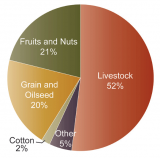 Image Reference: NASS1
Image Reference: NASS1
Agriculture in the United States is extremely diverse in the range of crops grown and animals raised, and produces over $200 billion a year in food commodities, with livestock accounting for more than half. Climate change will increase productivity in certain crops and regions and reduce productivity in others (see for example Midwest and Great Plains regions).2
Market Value of Agricultural Products Sold, 2002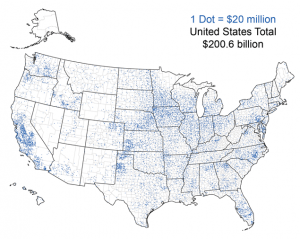 Image Reference: NASS1While climate change clearly affects agriculture, climate is also affected by agriculture, which contributes 13.5 percent of all human-induced greenhouse gas emissions globally. In the United States, agriculture represents 8.6 percent of the nation’s total greenhouse gas emissions, including 80 percent of its nitrous oxide emissions and 31 percent of its methane emissions.3
Image Reference: NASS1While climate change clearly affects agriculture, climate is also affected by agriculture, which contributes 13.5 percent of all human-induced greenhouse gas emissions globally. In the United States, agriculture represents 8.6 percent of the nation’s total greenhouse gas emissions, including 80 percent of its nitrous oxide emissions and 31 percent of its methane emissions.3
Increased agricultural productivity will be required in the future to supply the needs of an increasing population. Agricultural productivity is dependent upon the climate and land resources. Climate change can have both beneficial and detrimental impacts on plants. Throughout history, agricultural enterprises have coped with changes in climate through changes in management and in crop or animal selection. However, under higher heat-trapping gas emissions scenarios, the projected climate changes are likely to increasingly challenge U.S. capacity to as efficiently produce food, feed, fuel, and livestock products.
Temperature and Carbon Dioxide
Many crops show positive responses to elevated carbon dioxide and low levels of warming, but higher levels of warming often negatively affect growth and yields.
Crop responses in a changing climate reflect the interplay among three factors: rising temperatures, changing water resources, and increasing carbon dioxide concentrations. Warming generally causes plants that are below their optimum temperature to grow faster, with obvious benefits. For some plants, such as cereal crops, however, faster growth means there is less time for the grain itself to grow and mature, reducing yields.2 For some annual crops, this can be compensated for by adjusting the planting date to avoid late season heat stress.4
The grain-filling period (the time when the seed grows and matures) of wheat and other small grains shortens dramatically with rising temperatures. Analysis of crop responses suggests that even moderate increases in temperature will decrease yields of corn, wheat, sorghum, bean, rice, cotton, and peanut crops.2
Corn and Soybean Temperature Response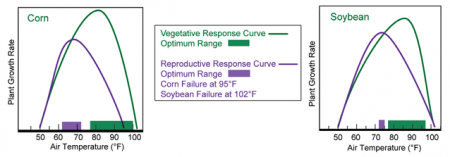 For each plant variety, there is an optimal temperature for vegetative growth, with growth dropping off as temperatures increase or decrease. Similarly, there is a range of temperatures at which a plant will produce seed. Outside of this range, the plant will not reproduce. As the graphs show, corn will fail to reproduce at temperatures above 95°F and soybean above 102°F. Image Reference: ARS USDA
For each plant variety, there is an optimal temperature for vegetative growth, with growth dropping off as temperatures increase or decrease. Similarly, there is a range of temperatures at which a plant will produce seed. Outside of this range, the plant will not reproduce. As the graphs show, corn will fail to reproduce at temperatures above 95°F and soybean above 102°F. Image Reference: ARS USDA
Some crops are particularly sensitive to high nighttime temperatures, which have been rising even faster than daytime temperatures.5 Nighttime temperatures are expected to continue to rise in the future. These changes in temperature are especially critical to the reproductive phase of growth because warm nights increase the respiration rate and reduce the amount of carbon that is captured during the day by photosynthesis to be retained in the fruit or grain. Further, as temperatures continue to rise and drought periods increase, crops will be more frequently exposed to temperature thresholds at which pollination and grain-set processes begin to fail and quality of vegetable crops decreases. Grain, soybean, and canola crops have relatively low optimal temperatures, and thus will have reduced yields and will increasingly begin to experience failure as warming proceeds.2 Common snap beans show substantial yield reduction when nighttime temperatures exceed 80°F.
Higher temperatures will mean a longer growing season for crops that do well in the heat, such as melon, okra, and sweet potato, but a shorter growing season for crops more suited to cooler conditions, such as potato, lettuce, broccoli, and spinach.2 Higher temperatures also cause plants to use more water to keep cool. This is one example of how the interplay between rising temperatures and water availability is critical to how plants respond to climate change. But fruits, vegetables, and grains can suffer even under well-watered conditions if temperatures exceed the maximum level for pollen viability in a particular plant; if temperatures exceed the threshold for that plant, it won’t produce seed and so it won’t reproduce.2
Temperature increases will cause the optimum latitude for crops to move northward; decreases in temperature would cause shifts toward the equator. Where plants can be efficiently grown depends upon climate conditions, of which temperature is one of the major factors.
Increase in Percent of Very Warm Nights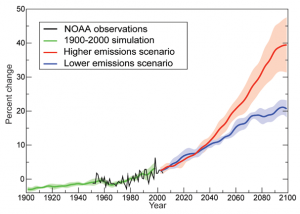 The graph shows the observed and projected change in percent of very warm nights from the 1950-1990 average in the United States. Under the lower emissions scenario,6 the percentage of very warm nights is projected to increase about 20 percent by 2100. Under the higher emissions scenario,6 it is projected to increase by about 40 percent.5 The shaded areas show the likely ranges while the lines show the central projections from a set of climate models. The projections appear smooth because they show the calculated average of many models. Image Source: adapted from CCSP SAP 3.35
The graph shows the observed and projected change in percent of very warm nights from the 1950-1990 average in the United States. Under the lower emissions scenario,6 the percentage of very warm nights is projected to increase about 20 percent by 2100. Under the higher emissions scenario,6 it is projected to increase by about 40 percent.5 The shaded areas show the likely ranges while the lines show the central projections from a set of climate models. The projections appear smooth because they show the calculated average of many models. Image Source: adapted from CCSP SAP 3.35
Plants need adequate water to maintain their temperature within an optimal range. Without water for cooling, plants will suffer heat stress. In many regions, irrigation water is used to maintain adequate temperature conditions for the growth of cool season plants (such as many vegetables), even in warm environments. With increasing demand and competition for freshwater supplies, the water needed for these crops might be increasingly limited. If water supply variability increases, it will affect plant growth and cause reduced yields. The amount and timing of precipitation during the growing season are also critical, and will be affected by climate change. Changes in season length are also important and affect crops differently.2
Higher carbon dioxide levels generally cause plants to grow larger. For some crops, this is not necessarily a benefit because they are often less nutritious, with reduced nitrogen and protein content. Carbon dioxide also makes some plants more water-use efficient, meaning they produce more plant material, such as grain, on less water.2 This is a benefit in water-limited areas and in seasons with less than normal rainfall amounts.
In some cases, adapting to climate change could be as simple as changing planting dates, which can be an effective no- or low-cost option for taking advantage of a longer growing season or avoiding crop exposure to adverse climatic conditions such as high temperature stress or low rainfall periods. Effectiveness will depend on the region, crop, and the rate and amount of warming. It is unlikely to be effective if a farmer goes to market when the supply-demand balance drives prices down. Predicting the optimum planting date for maximum profits will be more challenging in a future with increased uncertainty regarding climate effects on not only local productivity, but also on supply from competing regions.2
Another adaptation strategy involves changing to crop varieties with improved tolerance to heat or drought, or those that are adapted to take advantage of a longer growing season. This is less likely to be cost-effective for perennial crops, for which changing varieties is extremely expensive and new plantings take several years to reach maximum productivity. Even for annual crops, changing varieties is not always a low-cost option. Seed for new stress-tolerant varieties can be expensive, and new varieties often require investments in new planting equipment or require adjustments in a wide range of farming practices. In some cases, it is difficult to breed for genetic tolerance to elevated temperature or to identify an alternative variety that is adapted to the new climate and to local soils, practices, and market demands.
Fruits that require long winter chilling periods will experience declines. Many varieties of fruits (such as popular varieties of apples and berries) require between 400 and 1,800 cumulative hours below 45°F each winter to produce abundant yields the following summer and fall. By late this century, under higher emissions scenarios,6 winter temperatures in many important fruit-producing regions such as the Northeast will be too consistently warm to meet these requirements. Cranberries have a particularly high chilling requirement, and there are no known low-chill varieties. Massachusetts and New Jersey supply nearly half the nation’s cranberry crop. By the middle of this century, under higher emissions scenarios,6 it is unlikely that these areas will support cranberry production due to a lack of the winter chilling they need.7,8 Such impacts will vary by region. For example, though there will still be risks of early-season frosts and damaging winter thaws, warming is expected to improve the climate for fruit production in the Great Lakes region.4
A seemingly paradoxical impact of warming is that it appears to be increasing the risk of plant frost damage. Mild winters and warm, early springs, which are beginning to occur more frequently as climate warms, induce premature plant development and blooming, resulting in exposure of vulnerable young plants and plant tissues to subsequent late-season frosts. For example, the 2007 spring freeze in the eastern United States caused widespread devastation of crops and natural vegetation because the frost occurred during the flowering period of many trees and during early grain development on wheat plants.9 Another example is occurring in the Rocky Mountains where in addition to the process described above, reduced snow cover leaves young plants unprotected from spring frosts, with some plant species already beginning to suffer as a result10 (see Ecosystems sector).
Effects of Increased Air Pollution on Crop Yields
Ground-level ozone (a component of smog) is an air pollutant that is formed when nitrogen oxides emitted from fossil fuel burning interact with other compounds, such as unburned gasoline vapors, in the atmosphere,11 in the presence of sunlight. Higher air temperatures result in greater concentrations of ozone. Ozone levels at the land surface have risen in rural areas of the United States over the past 50 years, and they are forecast to continue increasing with warming, especially under higher emissions scenarios.6 Plants are sensitive to ozone, and crop yields are reduced as ozone levels increase. Some crops that are particularly sensitive to ozone pollution include soybeans, wheat, oats, green beans, peppers, and some types of cotton.2
Extreme Temperatures and Precipitation
Extreme events such as heavy downpours and droughts are likelyat least two-thirds chance of occurring to reduce crop yields because excesses or deficits of water have negative impacts on plant growth.
U.S. Corn Yields 1960 to 2008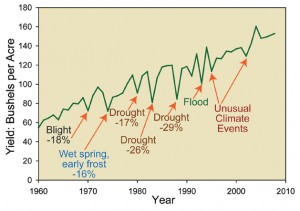 While technological improvements have resulted in a general increase in corn yields, extreme weather events have caused dramatic reductions in yields in particular years. Increased variation in yield is likely to occur as temperatures increase and rainfall becomes more variable during the growing season. Without dramatic technological breakthroughs, yields are unlikely to continue their historical upward trend as temperatures rise above the optimum level for vegetative and reproductive growth. Image Source: updated from NAST12One of the most pronounced effects of climate change is the increase in heavy downpours. Precipitation has become less frequent but more intense, and this pattern is projected to continue across the United States.13 One consequence of excessive rainfall is delayed spring planting, which jeopardizes profits for farmers paid a premium for early season production of high-value crops such as melon, sweet corn, and tomatoes. Field flooding during the growing season causes crop losses due to low oxygen levels in the soil, increased susceptibility to root diseases, and increased soil compaction due to the use of heavy farm equipment on wet soils. In spring 2008, heavy rains caused the Mississippi River to rise to about 7 feet above flood stage, inundating hundreds of thousands of acres of cropland. The flood hit just as farmers were preparing to harvest wheat and plant corn, soybeans, and cotton. Preliminary estimates of agricultural losses are around $8 billion.14 Some farmers were put out of business and others will be recovering for years to come. The flooding caused severe erosion in some areas and also caused an increase in runoff and leaching of agricultural chemicals into surface water and groundwater.7
While technological improvements have resulted in a general increase in corn yields, extreme weather events have caused dramatic reductions in yields in particular years. Increased variation in yield is likely to occur as temperatures increase and rainfall becomes more variable during the growing season. Without dramatic technological breakthroughs, yields are unlikely to continue their historical upward trend as temperatures rise above the optimum level for vegetative and reproductive growth. Image Source: updated from NAST12One of the most pronounced effects of climate change is the increase in heavy downpours. Precipitation has become less frequent but more intense, and this pattern is projected to continue across the United States.13 One consequence of excessive rainfall is delayed spring planting, which jeopardizes profits for farmers paid a premium for early season production of high-value crops such as melon, sweet corn, and tomatoes. Field flooding during the growing season causes crop losses due to low oxygen levels in the soil, increased susceptibility to root diseases, and increased soil compaction due to the use of heavy farm equipment on wet soils. In spring 2008, heavy rains caused the Mississippi River to rise to about 7 feet above flood stage, inundating hundreds of thousands of acres of cropland. The flood hit just as farmers were preparing to harvest wheat and plant corn, soybeans, and cotton. Preliminary estimates of agricultural losses are around $8 billion.14 Some farmers were put out of business and others will be recovering for years to come. The flooding caused severe erosion in some areas and also caused an increase in runoff and leaching of agricultural chemicals into surface water and groundwater.7
Another impact of heavy downpours is that wet conditions at harvest time result in reduced quality of many crops. Storms with heavy rainfall often are accompanied by wind gusts, and both strong winds and rain can flatten crops, causing significant damage. Vegetable and fruit crops are sensitive to even short-term, minor stresses, and as such are particularly vulnerable to weather extremes.2 More rainfall concentrated into heavy downpours also increases the likelihood of water deficiencies at other times because of reductions in rainfall frequency.
Drought frequency and severity are projected to increase in the future over much of the United States, particularly under higher emissions scenarios.15,6 Increased drought will be occurring at a time when crop water requirements also are increasing due to rising temperatures. Water deficits are detrimental for all crops.7
Temperature extremes will also pose problems. Even crop species that are well-adapted to warmth, such as tomatoes, can have reduced yield and/or quality when daytime maximum temperatures exceed 90°F for even short periods during critical reproductive stages (see Days Above 90°F maps in National Climate Change section).13 For many high-value crops, just hours or days of moderate heat stress at critical growth stages can reduce grower profits by negatively affecting visual or flavor quality, even when total yield is not reduced.16
Weeds, Insects, and Crop Diseases
Weeds, diseases, and insect pests benefit from warming, and weeds also benefit from a higher carbon dioxide concentration, increasing stress on crop plants and requiring more attention to pest and weed control.
Weeds benefit more than cash crops from higher temperatures and carbon dioxide levels.2 One concern with continued warming is the northward expansion of invasive weeds. Southern farmers currently lose more of their crops to weeds than do northern farmers. For example, southern farmers lose 64 percent of the soybean crop to weeds, while northern farmers lose 22 percent.17 Some extremely aggressive weeds plaguing the South (such as kudzu) have historically been confined to areas where winter temperatures do not drop below specific thresholds. As temperatures continue to rise, these weeds will expand their ranges northward into important agricultural areas.18 Kudzu currently has invaded 2.5 million acres of the Southeast and is a carrier of the fungal disease soybean rust, which represents a major and expanding threat to U.S. soybean production.8
Herbicide Loses Effectiveness at Higher CO2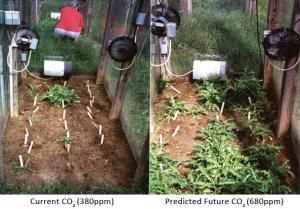 The left photo shows weeds in a plot grown at a carbon dioxide (CO2) concentration of about 380 parts per million (ppm), which approximates the current level. The right photo shows a plot in which the CO2 level has been raised to about 680 ppm. Both plots were equally treated with herbicide.7
The left photo shows weeds in a plot grown at a carbon dioxide (CO2) concentration of about 380 parts per million (ppm), which approximates the current level. The right photo shows a plot in which the CO2 level has been raised to about 680 ppm. Both plots were equally treated with herbicide.7
Controlling weeds currently costs the United States more than $11 billion a year, with the majority spent on herbicides;19 so both herbicide use and costs are likely to increase as temperatures and carbon dioxide levels rise. At the same time, the most widely used herbicide in the United States, glyphosate (RoundUp®), loses its efficacy on weeds grown at carbon dioxide levels that are projected to occur in the coming decades (see photos on left). Higher concentrations of the chemical and more frequent spraying thus will be needed, increasing economic and environmental costs associated with chemical use.7
Many insect pests and crop diseases thrive due to warming, increasing losses and necessitating greater pesticide use. Warming aids insects and diseases in several ways. Rising temperatures allow both insects and pathogens to expand their ranges northward. In addition, rapidly rising winter temperatures allow more insects to survive over the winter, whereas cold winters once controlled their populations. Some of these insects, in addition to directly damaging crops, also carry diseases that harm crops. Crop diseases in general are likelyat least two-thirds chance of occurring to increase as earlier springs and warmer winters allow proliferation and higher survival rates of disease pathogens and parasites.2,8 The longer growing season will allow some insects to produce more generations in a single season, greatly increasing their populations. Finally, plants grown in higher carbon dioxide conditions tend to be less nutritious, so insects must eat more to meet their protein requirements, causing greater destruction to crops.2
Due to the increased presence of pests, spraying is already much more common in warmer areas than in cooler areas. For example, Florida sweet corn growers spray their fields 15 to 32 times a year to fight pests such as corn borer and corn earworm, while New York farmers average zero to five times.2 In addition, higher temperatures are known to reduce the effectiveness of certain classes of pesticides (pyrethroids and spinosad).
Winter temperature Trends, 1975 to 2007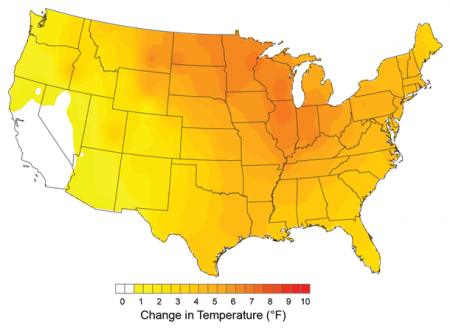 Temperatures are rising faster in winter than in any other season, especially in many key agricultural regions. This allows many insect pests and crop diseases to expand and thrive, creating increasing challenges for agriculture. As indicated by the map, the Midwest and northern Great Plains have experienced increases of more than 7ºF in average winter temperatures over the past 30 years. Image Reference: NOAA/NCDC20
Temperatures are rising faster in winter than in any other season, especially in many key agricultural regions. This allows many insect pests and crop diseases to expand and thrive, creating increasing challenges for agriculture. As indicated by the map, the Midwest and northern Great Plains have experienced increases of more than 7ºF in average winter temperatures over the past 30 years. Image Reference: NOAA/NCDC20
A particularly unpleasant example of how carbon dioxide tends to favor undesirable plants is found in the response of poison ivy to rising carbon dioxide concentrations. Poison ivy thrives in air with extra carbon dioxide in it, growing bigger and producing a more toxic form of the oil, urushiol, which causes painful skin reactions in 80 percent of people. Contact with poison ivy is one of the most widely reported ailments at poison centers in the United States, causing more than 350,000 cases of contact dermatitis each year. The growth stimulation of poison ivy due to increasing carbon dioxide concentration exceeds that of most other woody species. Given continued increases in carbon dioxide emissions, poison ivy is expected to become more abundant and more toxic in the future, with implications for forests and human health.8
Higher temperatures, longer growing seasons, and increased drought will lead to increased agricultural water use in some areas. Obtaining the maximum “carbon dioxide fertilization” benefit often requires more efficient use of water and fertilizers that better synchronize plant demand with supply. Farmers are likely to respond to more aggressive and invasive weeds, insects, and pathogens with increased use of herbicides, insecticides, and fungicides. Where increases in water and chemical inputs become necessary, this will increase costs for the farmer, as well as having society-wide impacts by depleting water supply, increasing reactive nitrogen and pesticide loads to the environment, and increasing risks to food safety and human exposure to pesticides.
Forage Quality and Quantity
Forage quality in pastures and rangelands generally declines with increasing carbon dioxide concentration because of the effects on plant nitrogen and protein content, reducing the land’s ability to supply adequate livestock feed.
Beef cattle production takes place in every state in the United States, with the greatest number raised in regions that have an abundance of native or planted pastures for grazing. Generally, eastern pasturelands are planted and managed, whereas western rangelands are native pastures, which are not seeded and receive much less rainfall. There are transformations now underway in many semi-arid rangelands as a result of increasing atmospheric carbon dioxide concentration and the associated climate change. These transformations include which species of grasses dominate, as well as the forage quality of the dominant grasses. Increases in carbon dioxide are generally reducing the quality of the forage, so that more acreage is needed to provide animals with the same nutritional value, resulting in an overall decline in livestock productivity. In addition, woody shrubs and invasive cheatgrass are encroaching into grasslands, further reducing their forage value.2 The combination of these factors leads to an overall decline in livestock productivity.
While rising atmospheric carbon dioxide concentration increases forage quantity, it has negative impacts on forage quality because plant nitrogen and protein concentrations often decline with higher concentrations of carbon dioxide.2 This reduction in protein reduces forage quality and counters the positive effects of carbon dioxide enrichment on carbohydrates. Rising carbon dioxide concentration also has the potential to reduce the digestibility of forages that are already of poor quality. Reductions in forage quality could have pronounced detrimental effects on animal growth, reproduction, and survival, and could render livestock production unsustainable unless animal diets are supplemented with protein, adding more costs to production. On shortgrass prairie, for example, a carbon dioxide enrichment experiment reduced the protein concentration of autumn forage below critical maintenance levels for livestock in 3 out of 4 years and reduced the digestibility of forage by 14 percent in mid-summer and by 10 percent in autumn. Significantly, the grass type that thrived the most under excess carbon dioxide conditions also had the lowest protein concentration.2
Distribution of Beef Cattle and Pasture/Rangeland in Continental U.S.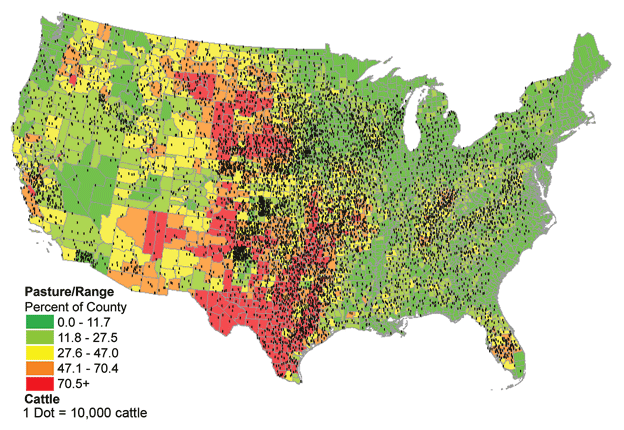 The colors show the percent of the county that is cattle pasture or rangeland, with red indicating the highest percentage. Each dot represents 10,000 cattle. Livestock production occurs in every state. Increasing concentration of carbon dioxide reduces the quality of forage, necessitating more acreage and resulting in a decline in livestock productivity. Image References: NASS1, NRCS21
The colors show the percent of the county that is cattle pasture or rangeland, with red indicating the highest percentage. Each dot represents 10,000 cattle. Livestock production occurs in every state. Increasing concentration of carbon dioxide reduces the quality of forage, necessitating more acreage and resulting in a decline in livestock productivity. Image References: NASS1, NRCS21
At the scale of a region, the composition of forage plant species is determined mostly by climate and soils. The primary factor controlling the distribution and abundance of plants is water: both the amount of water plants use and water availability over time and space. The ability to anticipate vegetation changes at local scales and over shorter periods is limited because at these scales the response of vegetation to global-scale changes depends on a variety of local processes including the rate of disturbances such as fire and grazing, and the rate at which plant species can move across sometimes-fragmented landscapes. Nevertheless, some general patterns of vegetation change are beginning to emerge. For example, experiments indicate that a higher carbon dioxide concentration favors weeds and invasive plants over native species because invasives have traits (such as rapid growth rate and prolific seed production) that allow a larger growth response to carbon dioxide. In addition, the effect of a higher carbon dioxide concentration on plant species composition appears to be greatest where the land has been disturbed (such as by fire or grazing) and nutrient and light availability are high.2
Increases in temperature lengthen the growing season, and thus are likelyat least two-thirds chance of occurring to extend forage production into the late fall and early spring. However, overall productivity remains dependent on precipitation during the growing season.2
Livestock Productivity
Increased heat, disease, and weather extremes are likelyat least two-thirds chance of occurring to reduce livestock productivity.
Like human beings, cows, pigs, and poultry are warm-blooded animals that are sensitive to heat. In terms of production efficiency, studies show that the negative effects of hotter summers will outweigh the positive effects of warmer winters. The more the U.S. climate warms, the more production will fall. For example, an analysis projected that a warming in the range of 9 to 11°F (as in the higher emissions scenarios6) would cause a 10 percent decline in livestock yields in cow/calf and dairy operations in Appalachia, the Southeast (including the Mississippi Delta), and southern Plains regions, while a warming of 2.7°F would cause less than a 1 percent decline.
Temperature and humidity interact to cause stress in animals, just as in humans; the higher the heat and humidity, the greater the stress and discomfort, and the larger the reduction in the animals’ ability to produce milk, gain weight, and reproduce. Milk production declines in dairy operations, the number of days it takes for cows to reach their target weight grows longer in meat operations, conception rate in cattle falls, and swine growth rates decline due to heat. As a result, swine, beef, and milk production are all projected to decline in a warmer world.2
The projected increases in air temperatures will negatively affect confined animal operations (dairy, beef, and swine) located in the central United States, increasing production costs as a result of reductions in performance associated with lower feed intake and increased requirements for energy to maintain healthy livestock. These costs do not account for the increased death of livestock associated with extreme weather events such as heat waves. Nighttime recovery is an essential element of survival when livestock are stressed by extreme heat. A feature of recent heat waves is the lack of nighttime relief. Large numbers of deaths have occurred in recent heat waves, with individual states reporting losses of 5,000 head of cattle in a single heat wave in one summer.2
Warming also affects parasites and disease pathogens. The earlier arrival of spring and warmer winters allow greater proliferation and survival of parasites and disease pathogens.2 In addition, changes in rainfall distributions are likelyat least two-thirds chance of occurring to lead to changes in diseases sensitive to moisture. Heat stress reduces animals’ ability to cope with other stresses, such as diseases and parasites. Furthermore, changes in rainfall distributions could lead to changes in diseases sensitive to relative humidity.
Maintaining livestock production would require modifying facilities to reduce heat stress on animals, using the best understanding of the chronic and acute stresses that livestock will encounter to determine the optimal modification strategy.2
Changing livestock species as an adaptation strategy is a much more extreme, high-risk, and, in most cases, high-cost option than changing crop varieties. Accurate predictions of climate trends and development of the infrastructure and market for the new livestock products are essential to making this an effective response.
Primary Sources
References
- 1. a. b. c. [232] Service, National Agricultrual Statistics. 2002 Census of Agriculture. Washington, D.C.: USDA National Agricultural Statistics Service, 2002.
- 2. a. b. c. d. e. f. g. h. i. j. k. l. m. n. o. p. q. r. s. t. u. v. w. x. [193] Hatfield, J., K. Boote, P. Fay, L. Hahn, C. Izaurralde, B. A. Kimball, T. Mader, J. Morgan, D. Ort, W. Polley et al. "Agriculture." In The Effects of Climate Change on Agriculture, Land Resources, and Biodiversity in the United States, edited by P. Backlund, A. Janetos, D. Schimel, J. Hatfield, K. Boote, P. Fay, L. Hahn, C. Izaurralde, B. A. Kimball, T. Mader et al., 21-74. Vol. Synthesis and Assessment Product 4.3. Washington, D.C.: U.S. Department of Agriculture, 2008.
- 3. [221] EPA. Inventory of U.S. Greenhouse Gas Emissions and Sinks: 1990 - 2006. Washington, D.C.: U.S. Environmental Protection Agency, 2008.
- 4. a. b. [164] Field, C., L. D. Mortsch, M. Brklacich, D. L. Forbes, P. Kovacs, J. A. Patz, S. W. Running, and M. J. Scott. "North America." In Climate Change 2007: Impacts Adaptation and Vulnerabiltiy, edited by M. L. Parry, O. F. Canziani, J. P. Palutikof, P. J. van der Linden and C. E. Hanson, 617-652. Vol. Contribution of Working Group II to the Fourth Assessment Report of the Intergovernmental Panel on Climate Change. Cambridge, UK and New York, NY: Cambridge University Press, 2007.
- 5. a. b. c. [68] Gutowski, W. J., G. C. Hegerl, G. J. Holland, T. R. Knutson, L. Mearns, R. J. Stouffer, P. J. Webster, M. F. Wehner, and F. W. Zwiers. "Causes of Observed Changes in Extremes and Projections of Future Changes." In Weather and Climate Extremes in a Changing Climate: Regions of Focus: North America, Hawaii, Caribbean, and U.S. Pacific Islands, edited by T. R. Karl, G. A. Meehl, C. D. Miller, S. J. Hassol, A. M. Waple and W. L. Murray, 81-116. Vol. Synthesis and Assessment Product 3.3. Washington, D.C.: U.S. Climate Change Science Program, 2008.
- 6. a. b. c. d. e. f. g. [91] various. footnote 91., 2009.
- 7. a. b. c. d. e. [233] Wolfe, D., L. Ziska, C. Petzoldt, A. Seaman, L. Chase, and K. Hayhoe. "Projected Change in Climate Thresholds in the Northeastern U.S.: Implications for Crops, Pests, Livestock, and Farmers." Mitigation and Adaptation Strategies for Global Change 13, no. 5-6 (2007): 555-575.
- 8. a. b. c. d. [234] Frumhoff, P. C., J. J. McCarthy, J. Melillo, S. C. Moser, and D. Wuebbles. Confronting Climate Change in the U. S. Northeast: Science, Impacts, and Solutions. Vol. Synthesis Report of the Northeast Climate Impacts Assessment. Cambridge, MA: Union of Concerned Scientists, 2007.
- 9. [235] Gu, L., P. J. Hanson, W. Mac Post, D. P. Kaiser, B. Yang, R. Nemani, S. G. Pallardy, and T. Meyers. "The 2007 Eastern U.S. Spring Freeze: Increased Cold Damage in a Warming World?" BioScience 58, no. 3 (2008): 253-262.
- 10. [236] Inouye, D. W.. "Effects of Climate Change on Phenology, Frost Damage, and Floral Abundance of Montane Wildflowers." Ecology 89, no. 2 (2008): 353-362.
- 11. [237] various. footnote 237., 2009.
- 12. [219] Team, National Assessment Synthesis. Climate Change impacts on the United States: The Potential Consequences of Climate Variability and Change. Cambridge, UK and New York, NY, 2001.
- 13. a. b. [112] Kunkel, K., P. D. Bromirski, H. E. Brooks, T. Cavazos, A. V. Douglas, D. R. Easterling, K. Emanuel, P.Ya. Groisman, G. J. Holland, T. R. Knutson et al. "Observed Changes in Weather and Climate Extremes." In Weather and Climate Extremes in a Changing Climate: Regions of Focus: North America, Hawaii, Caribbean, and U.S. Pacific Islands, edited by T. R. Karl, G. A. Meehl, C. D. Miller, S. J. Hassol, A. M. Waple and W. L. Murray, 35-80. Vol. CCSP Synthesis and Assessment Product 3.3. Washington, D.C.: U.S. Climate Change Science Program, 2008.
- 14. [213] Center, NOAA's National Climatic Data. Midwestern U.S. Flood Overview., 2008.
- 15. [90] Meehl, G. A., T. F. Stocker, W. D. Collins, P. Friedlingstein, A. T. Gaye, JM Gregory, A. Kitoh, R. Knutti, J. M. Murphy, A. Noda et al. "Global Climate Projections." In Climate Change 2007: The Physical Basis, edited by S. Solomon, D. Qin, M. Manning, Z. Chen, M. Marquis, K. B. Averyt, M. Tignor and H. L. Miller, 747-845. Vol. Contribution of Working Group I to the Fourth Assessment Report of the Intergovernmental Panel on Climate Change. Cambridge, UK and New York, NY: Cambridge University Press, 2007.
- 16. [238] Peet, M. M., and D. W. Wolf. "Crop Ecosystem Responses to Climate Change: Vegetable Crops." In Climate Change and Global Crop Productivity, edited by K. R. Reddy and K. F. Hodges, 472 pp. New York, NY and Wallingford, UK: CABI Publishing, 2000.
- 17. [239] Crop Losses Due to Weeds in the United States, Edited by D. C. Bridges. Champaign, IL: Weed Science Society of America, 1992.
- 18. [240] Joyce, L. A., G. M. Blate, J. S. Littell, S. G. McNulty, C. I. Millar, S. C. Moser, R. P. Neilson, K. O'Halloran, and D. L. Peterson. "National Forests." In Preliminary Review of Adaptation Options for Climate-sensitive Ecosystems and Resources, edited by S. H. Julius and J. M. West, 3-1 to 3-127. Vol. Synthesis and Assessment Product 4.4. Washington, D.C.: U.S. Environmental Protection Agency, 2008.
- 19. [241] Kiely, T., D. Donaldson, and A. Grube. Pesticides Industry Sales and Usage: 2000 and 2001 Market Estimates. Washington, D.C.: U.S. Environmental Protection Agency, 2004.
- 20. [107] various. footnote 107., 2009.
- 21. [242] Service, Natural Resources Conservation. 1997 Five-year Natural Resources Inventory. Washington, D.C.: USDA Natural Resources Conservation Service, 1997.